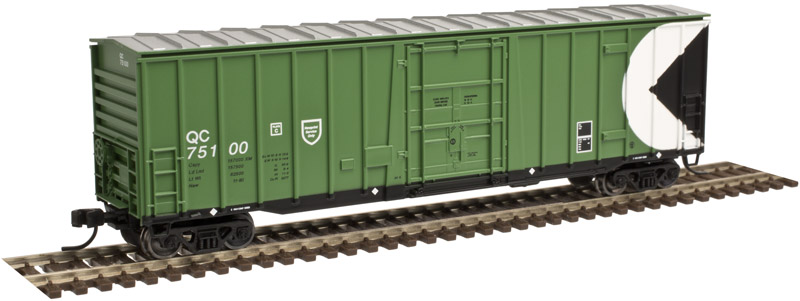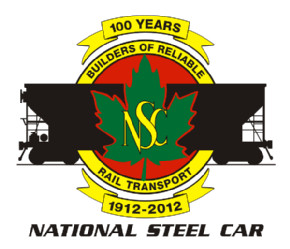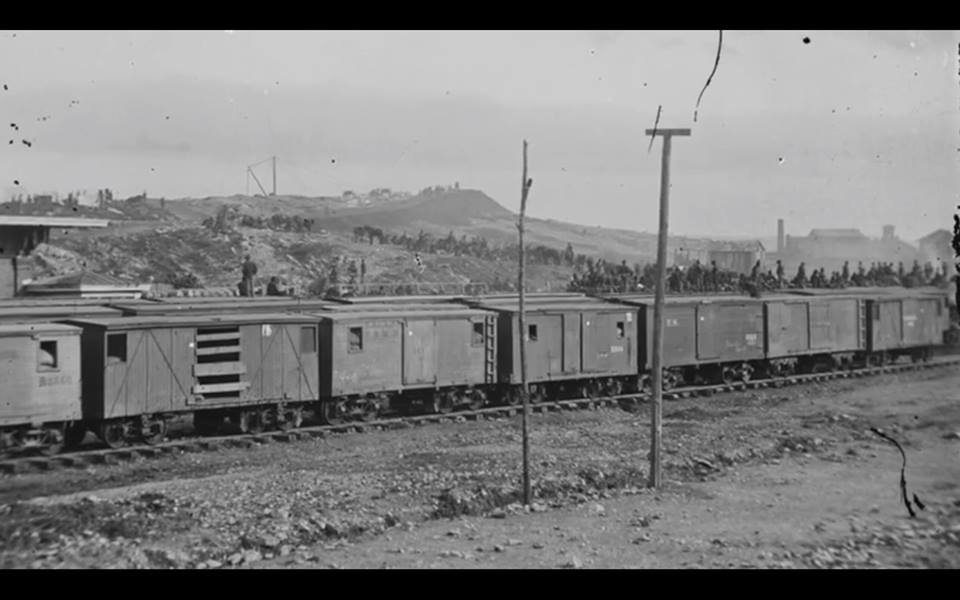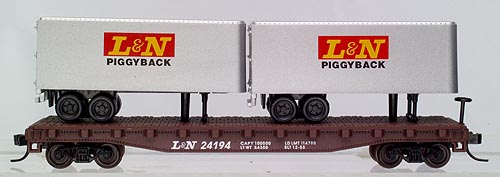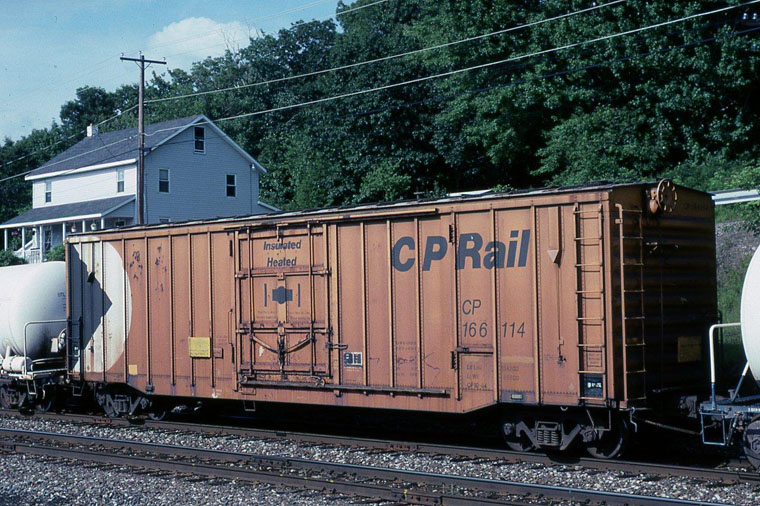Model Information: This Atlas model was first announced in February of 2015 for A 3rd quarter 2015 delivery. The actual delivery was likely later. It models a National Steel Car (NSC) prototype from the 1970s and 1980s.
Prototype History: Steel boxcars became the de facto standard for railcar service sometime in the late 1950s. Every major railcar manufacturer had their own version. Plug-door cars held a better seal for air coming in and out of the car interior and operated much the same way a modern minivan side door works. A common feature for plug door cars such as the offering from NSC was an insulated interior to further protect the contents from the elements. From 1975 to 1980 National Steel Car built over one-thousand 50’6” single-plug door box cars. This being the post-roofwalk era, these cars have a simple aluminum roof. The model 5277 had an interior capacity of 5,277 c.f. and the model 5177 had a capacity of 5,177 c.f. Most of the 100-ton cars went to Canadian railroads primarily for paper service. Two hundred 70-ton cars went into food service for the Grand Trunk Western.
Road Name History: 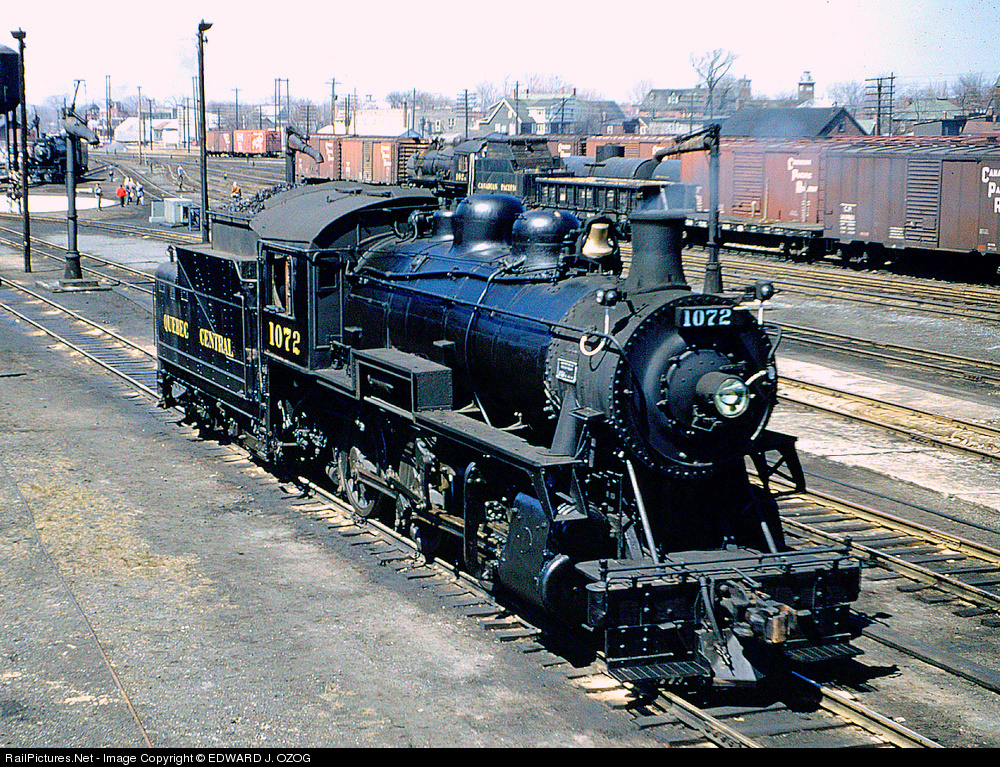 The QCR was established in 1869 under the name Sherbrooke Eastern Townships & Kennebec Railway but adopted the Quebec Central name six years later. The line connected the Eastern Townships region of Quebec (a region between the St. Lawrence River and the U.S. border) to a connection with Canadian Pacific’s International of Maine subsidiary. The 300 mile line was headquartered in Sherbrooke. In 1912, QCR was leased by Canadian Pacific for 99 years but continued to operate under their own name. In 1926, QCR leased the Massawippi Valley Railway from Lennoxville to Newport. This made QCR part of a desirable route for passengers from Quebec City to ice free Atlantic ports via CP’s International of Maine.
The QCR was established in 1869 under the name Sherbrooke Eastern Townships & Kennebec Railway but adopted the Quebec Central name six years later. The line connected the Eastern Townships region of Quebec (a region between the St. Lawrence River and the U.S. border) to a connection with Canadian Pacific’s International of Maine subsidiary. The 300 mile line was headquartered in Sherbrooke. In 1912, QCR was leased by Canadian Pacific for 99 years but continued to operate under their own name. In 1926, QCR leased the Massawippi Valley Railway from Lennoxville to Newport. This made QCR part of a desirable route for passengers from Quebec City to ice free Atlantic ports via CP’s International of Maine.
Passenger service ended in 1967. By 1994, freight traffic had fallen below what was sustainable and Canadian Pacific shut down operations on the line. Since CP was just the lessor (they only owned a 10% stake in the company) they couldn’t actually abandon it and pull up the track. So it sat unused for five years before a local entrepreneur bought the Quebec Central and re-opened it in the summer of 2000. The new owners made a go of freight service and introduced tourist trains as well. However, it soon became clear that they were not going to cover their costs and the Quebec Central closed for good in 2006.

Passenger service ended in 1967. By 1994, freight traffic had fallen below what was sustainable and Canadian Pacific shut down operations on the line. Since CP was just the lessor (they only owned a 10% stake in the company) they couldn’t actually abandon it and pull up the track. So it sat unused for five years before a local entrepreneur bought the Quebec Central and re-opened it in the summer of 2000. The new owners made a go of freight service and introduced tourist trains as well. However, it soon became clear that they were not going to cover their costs and the Quebec Central closed for good in 2006.
Brand/Importer Information: In 1924 Stephan Schaffan, Sr. founded the Atlas Tool Company in Newark, New Jersey. In 1933 his son, Stephan Schaffan, Jr., came to work for his father at the age of sixteen. Steve Jr. built model airplanes as a hobby and frequented a local hobby shop. Being an enterprising young man, he would often ask the owner if there was anything he could do to earn some extra spending money. Tired of listening to his requests, the hobby-store owner threw some model railroad track parts his way and said, "Here, see if you can improve on this".
In those days, railroad modelers had to assemble and build everything from scratch. Steve Jr. created a "switch kit" which sold so well, that the entire family worked on them in the basement at night, while doing business as usual in the machine shop during the day.
Subsequently, Steve Jr. engineered the stapling of rail to fiber track, along with inventing the first practical rail joiner and pre-assembled turnouts and flexible track. All of these products, and more, helped to popularize model railroading and assisted in the creation of a mass-market hobby. The budding entrepreneur quickly outgrew the limitations of a basement and small garage operation. Realizing they could actually make a living selling track and related products, Steve and his father had the first factory built in Hillside, New Jersey at 413 Florence Avenue in 1947. On September 30, 1949, the Atlas Tool Company was officially incorporated as a New Jersey company.
In 1985, Steve was honored posthumously for his inventions by the Model Railroad Industry Association and was inducted into the Model Railroad Industry Hall of Fame in Baltimore, Maryland. In addition, Steve was nominated and entered into the National Model Railroad Association Pioneers of Model Railroading in 1995.
In the early 1990s, the Atlas Tool Company changed its name to Atlas Model Railroad Company, Inc.
In those days, railroad modelers had to assemble and build everything from scratch. Steve Jr. created a "switch kit" which sold so well, that the entire family worked on them in the basement at night, while doing business as usual in the machine shop during the day.
Subsequently, Steve Jr. engineered the stapling of rail to fiber track, along with inventing the first practical rail joiner and pre-assembled turnouts and flexible track. All of these products, and more, helped to popularize model railroading and assisted in the creation of a mass-market hobby. The budding entrepreneur quickly outgrew the limitations of a basement and small garage operation. Realizing they could actually make a living selling track and related products, Steve and his father had the first factory built in Hillside, New Jersey at 413 Florence Avenue in 1947. On September 30, 1949, the Atlas Tool Company was officially incorporated as a New Jersey company.
In 1985, Steve was honored posthumously for his inventions by the Model Railroad Industry Association and was inducted into the Model Railroad Industry Hall of Fame in Baltimore, Maryland. In addition, Steve was nominated and entered into the National Model Railroad Association Pioneers of Model Railroading in 1995.
In the early 1990s, the Atlas Tool Company changed its name to Atlas Model Railroad Company, Inc.
Item created by: gdm on 2017-01-01 08:06:19. Last edited by Alain LM on 2021-03-13 05:19:54
If you see errors or missing data in this entry, please feel free to log in and edit it. Anyone with a Gmail account can log in instantly.
If you see errors or missing data in this entry, please feel free to log in and edit it. Anyone with a Gmail account can log in instantly.


